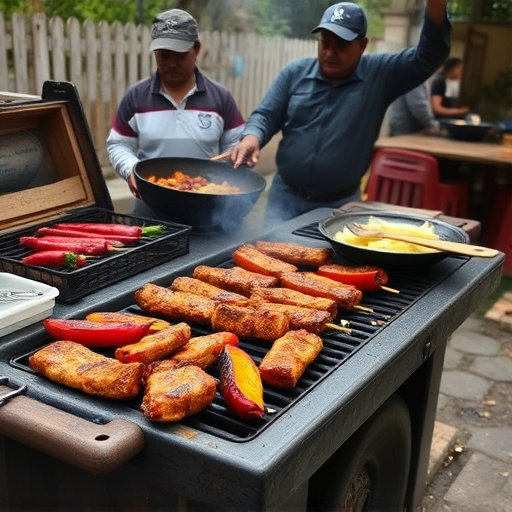Choosing the perfect BBQ ribs starts with high-quality, meaty cuts with good marbling. Baby back ribs are quicker to cook, while spare ribs require longer times. Seasoning is key; dry rubs lock in moisture and enhance flavor, while wet marinades penetrate meat for juiciness. Precise temperature control at 225°F (107°C) ensures tender results. Smoking or direct heat grilling offers distinct flavors; brining further enhances taste and tenderness. Present ribs on hot plates with fresh herbs, coleslaw, baked beans, and barbecue sauce for a memorable dining experience.
“Unleash your inner BBQ maestro with our comprehensive guide to grilling perfection! Discover the secrets behind crafting mouthwatering barbecue ribs. From selecting the ideal ribs for your feast to mastering temperature control, we’ve got you covered. Learn about the art of seasoning and marinades to transform ordinary ribs into a symphony of flavors. Explore various grilling methods, including smoking and direct heat, to achieve tender, juicy results every time. Whether you’re a pro or novice, this guide offers valuable tips for presenting and serving your BBQ ribs like a true champion.”
- Choosing the Right Ribs for Your BBQ
- Seasoning and Marinades: Enhancing Flavor
- The Art of Grilling: Temperature Control
- Smoking vs. Direct Heat: Understanding Methods
- Brining for Tender, Juicy Results
- Slow Cooking for Fall-Off-the-Bone Ribs
- Presenting and Serving Your BBQ Ribs
Choosing the Right Ribs for Your BBQ
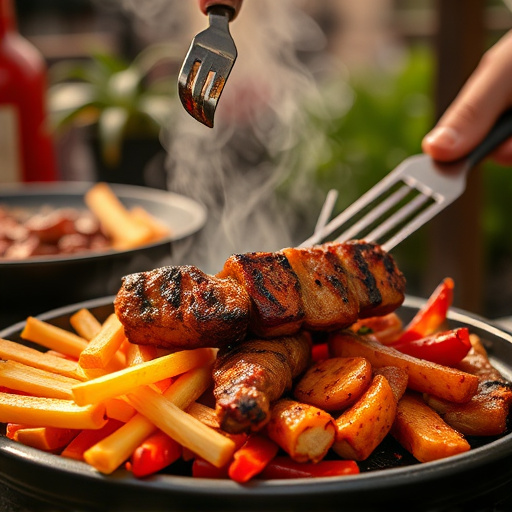
When it comes to choosing the perfect BBQ ribs for your grill, selection is key. Opt for high-quality, meaty ribs with a good marbling of fat—this ensures they stay juicy and tender during cooking. The most common cuts are baby back ribs and spare ribs; both offer distinct flavors but require slightly different grilling techniques. Baby back ribs, with their smaller size and less bone, cook faster and are great for those new to BBQing. Spare ribs, on the other hand, have more meat and bone, resulting in a heartier meal but need longer cooking times.
Consider the source of your ribs too; grass-fed or organic options tend to offer better flavor and texture. Regardless of your choice, prepare them by stripping off any silver skin and trimming excess fat for optimal grilling results in your bbq ribs recipe.
Seasoning and Marinades: Enhancing Flavor
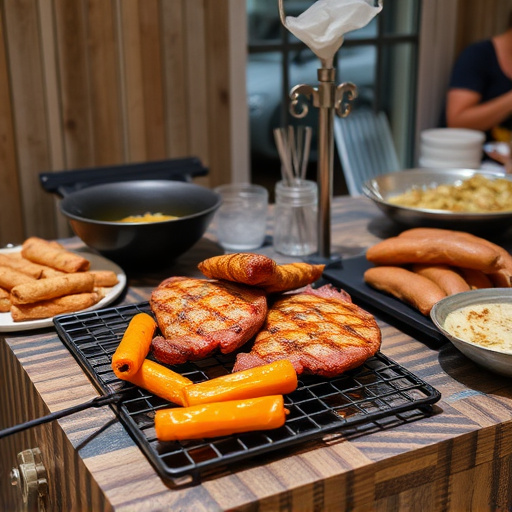
Seasoning and marinades play a pivotal role in transforming simple barbecue ribs into mouthwatering culinary delights. Before hitting the grill, it’s essential to infuse your ribs with rich flavors that will tantalize your taste buds. A good bbq ribs recipe involves a combination of dry rubs and wet marinades. Dry rubs, made from a blend of spices like paprika, garlic powder, salt, pepper, and brown sugar, create a crispy outer layer while locking in moisture. These seasonings not only enhance the meat’s natural flavor but also contribute to its tender texture.
Wet marinades, on the other hand, are concoctions of oil, vinegar, lemon juice, herbs, and spices. They penetrate the meat, making it juicier and more flavorful. A simple marinade for bbq ribs could include olive oil, apple cider vinegar, brown sugar, Worcestershire sauce, garlic, and your favorite herbs like thyme or rosemary. Letting the ribs sit in this mixture for a few hours before grilling allows the flavors to permeate every inch of the meat, ensuring a truly exceptional barbecue experience.
The Art of Grilling: Temperature Control
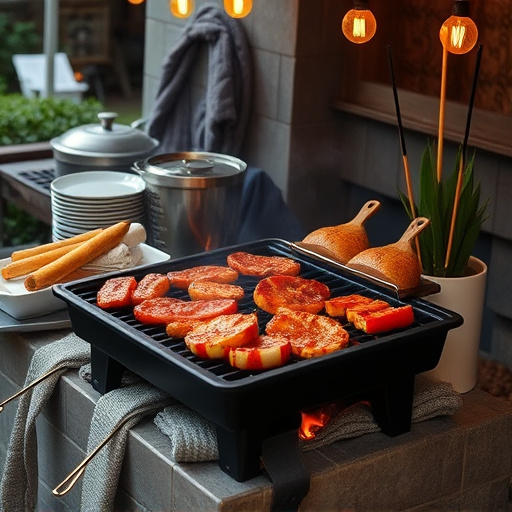
The key to grilling perfect BBQ ribs lies in temperature control—a subtle art that transforms raw meat into tender, juicy goodness. Preheating your grill to the right temperature is step one; aim for around 225°F (107°C) for slow-cooking ribs. This gentle heat allows the collagen in the ribs to break down slowly, ensuring a tender result without overcooking the exterior.
Regularly checking and maintaining this consistent temperature is crucial. Use a reliable grill thermometer to monitor the heat, adjusting your burner settings as needed. This meticulous control prevents sudden spikes that can burn the ribs’ delicious sauce or dry out the meat, resulting in a perfect BBQ rib recipe every time.
Smoking vs. Direct Heat: Understanding Methods
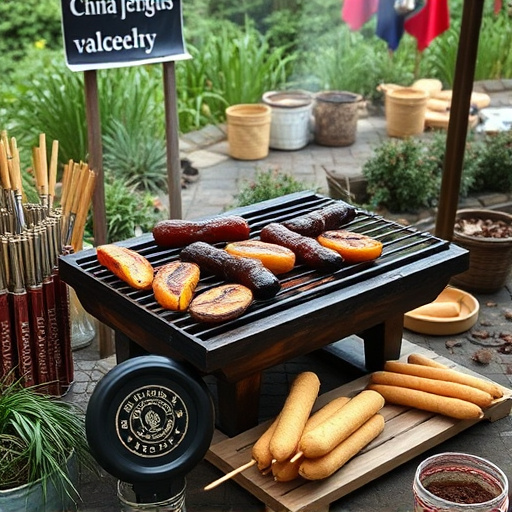
When it comes to grilling BBQ ribs, understanding the difference between smoking and direct heat methods is key to achieving perfection. Smoking involves slowly cooking ribs at lower temperatures (around 225-250°F) using indirect heat, usually from wood chips or chunks. This method infuses the ribs with a smoky flavor and tenderizes them over time. It’s ideal for larger cuts of meat that benefit from slow, moist cooking, resulting in fall-off-the-bone ribs.
On the other hand, direct heat grilling utilizes high temperatures (around 400-500°F) to cook ribs quickly. This technique sears the exterior, locking in flavors and juices. While it doesn’t create the same depth of smoky flavor as smoking, it’s perfect for achieving a crispy, caramelized crust on the ribs’ surface. Direct heat is suitable for smaller cuts or when you want a quicker cooking time without sacrificing taste.
Brining for Tender, Juicy Results
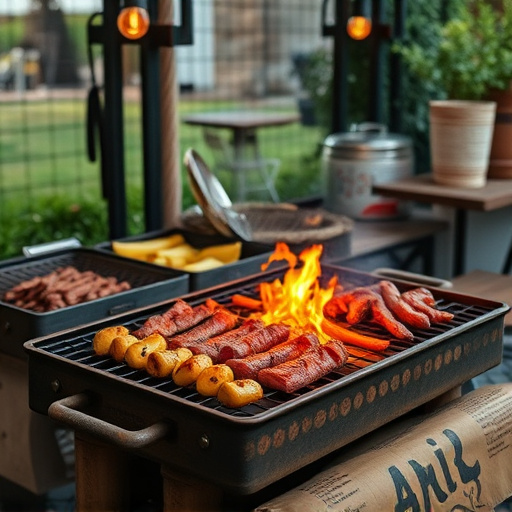
Brining is an often-overlooked but powerful technique to transform your BBQ ribs into mouthwatering, tender treats. By submerging your ribs in a solution of salt, sugar, and spices before grilling, you’re essentially marinating them from the inside out. This process helps break down the collagen in the meat, resulting in a juicier and more succulent end product. The brining solution not only enhances flavor but also ensures that your ribs stay moist during the long cooking hours on the grill.
For best results, plan ahead as brining typically requires several hours or even overnight immersion. Choose a balanced mix of coarse salt, brown sugar, paprika, garlic powder, and black pepper to create a flavorful brine. Ensure your ribs are thoroughly coated before placing them in the fridge for brining. This simple step can significantly improve the overall quality of your BBQ ribs recipe, making them tender, juicy, and ready to impress your taste buds.
Slow Cooking for Fall-Off-the-Bone Ribs
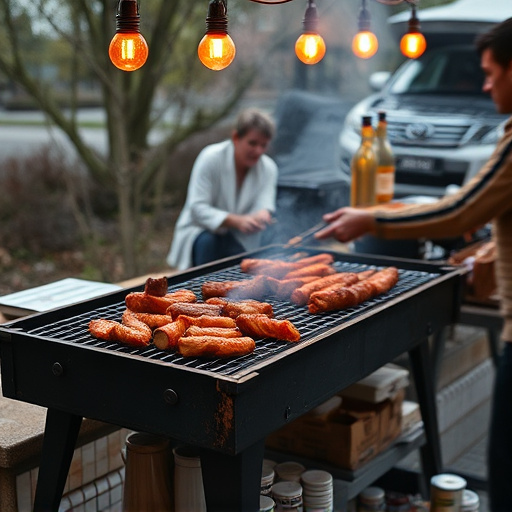
For truly mouthwatering barbecue ribs, slow cooking is a game-changer. This method allows the meat to tenderize and the flavors to meld together, resulting in ribs that literally fall off the bone. Start by applying your favorite dry rub or marinade to the ribs several hours or even a day before grilling. This step enhances the flavor profile of your bbq ribs recipe.
Next, preheat your grill to low heat, aiming for around 225°F (107°C). This temperature is ideal for slow cooking. Place the ribs on the grill and cook them until they become tender, which typically takes anywhere from 3 to 4 hours. Keep the ribs covered during this process to lock in moisture and achieve that perfect fall-off-the-bone texture.
Presenting and Serving Your BBQ Ribs
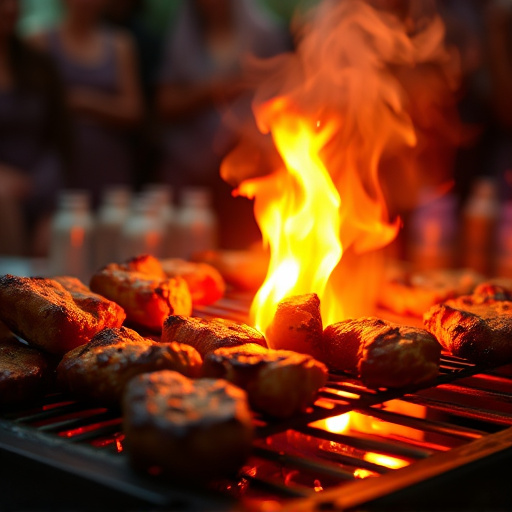
After your ribs have finished grilling and achieving that beautiful, crispy bark while locking in juicy flavors, it’s time to present them with all their glory. Arrange the ribs on a large serving platter or individual plates, ensuring they’re still hot for optimal dining experience. A simple sprinkle of chopped fresh herbs like parsley or cilantro can add a burst of color and freshness. Accompany your BBQ ribs recipe grill with classic sides like coleslaw, baked beans, or grilled corn to round out the meal.
For an extra touch, consider brushing a tangy barbecue sauce over the ribs just before serving. This not only enhances the flavor but also ensures they stay moist and tender. Whether you’re hosting a backyard gathering or sharing a family dinner, presenting your perfectly cooked BBQ ribs in style will make every bite memorable, satisfying both taste buds and eyes.
